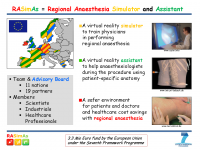One year after launching their project, scientists, physicians and industrialists of the RASimAs team met at the Foundation for Research & Technology Hellas (Heraklion, Greece) to draw a strategy for the coming years.

The Regional Anaesthesia Simulator and Assistant (RASimAs) project aims at providing both a simulator and an assistant in order to train medical doctors at the practise of Regional Anaesthesia and assist them during the actual operation. The ambitious project is coordinated by Prof. Thomas Deserno from the Department of Medical Informatics at Uniklinik RWTH Aachen (Germany) and gathers a consortium of 14 academic, clinical and industrial partners from ten different European countries. “International specialists from science, patient care, and industry cooperate for medical innovation. We aim at creating cutting-edge technology”, recalls Prof. Deserno.
This VPH project is funded with 3.3 million Euros by the European Union under the Seventh Framework Programme. So far, data and functional interfaces and modules have been defined and implemented, and the first pieces of hardware and software for the prototypes have been assembled with the help of an international advisory board.
“Despite technical challenges inherent to projects at the leading-edge of research, the consortium is clearly heading towards a pioneering project in the field of medical simulation and assistance” explains Prof. Nicholas Avis, Executive Dean of the Faculty of Science and Engineering at the University of Chester (UK) and member of this board. The challenges for the next years will consist of finalising these prototypes and validating them through a multi-centre clinical trial performed in Germany, Belgium, and Ireland.
More information on RASimAs can be found of the project website